FIRST EDITION, LIMITED TO 500 COPIES, OF RAVENSTEIN’S AUTHORITATIVE ACCOUNT
OF THE EARLIEST SURVIVING TERRESTRIAL GLOBE
RAVENSTEIN, Ernst Georg. Martin Behaim. His Life and his Globe … With a Facsimile of the Globe Printed in Colours, Eleven Maps and Seventeen Illustrations. London: George Philip & Son, Ltd., 1908.
Folio (388 x 314mm), pp. viii, 122, [2 (‘Index of the Facsimile of Behaim’s Globe’, verso blank)]. Half-tone portrait frontispiece. One plate printed by G.P.J. Bieling-Dietz from a block depicting Behaim’s arms and designed by Albrecht Dürer (vide infra), 4 half-tone plates after F. Schmidt et al., and 4 colour-printed maps. Lithographic facsimile of globe gores and polar calottes printed by W. Griggs in colours, silver, and gold on four folding sheets, loose as issued in pocket on lower pastedown. Illustrations, diagrams, and maps in the text, one full-page. Letterpress tables in the text. (Some spotting, heavier on first few ll., offsetting and ink-marking on blank versos of globe facsimiles.) Original holland-backed boards, upper board reproducing block of Behaim’s arms, spine lettered in black, top edges gilt, others trimmed. (Spine slightly darkened, some light marking, corners slightly rubbed and bumped.) A very good copy. Provenance: Nottingham High School, Nottingham (20th-century booklabel on upper pastedown; sold on their behalf).
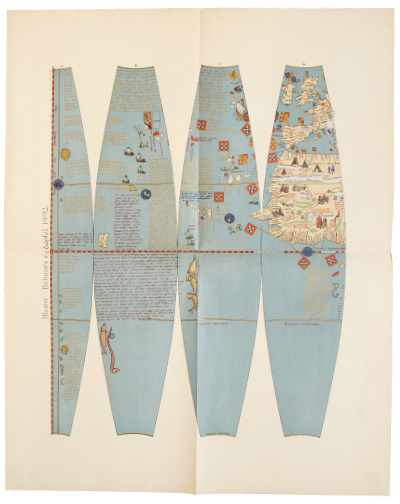
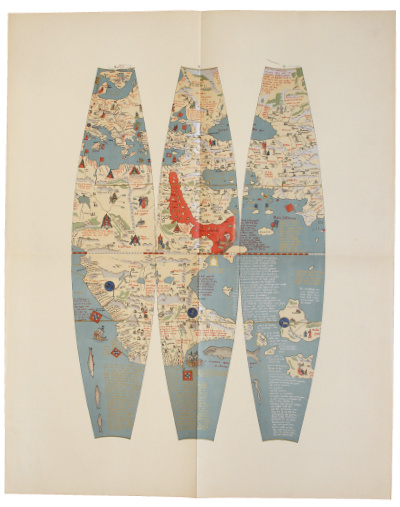

First edition, no. 389 of 510 copies. The ‘Behaim Globe’ is the oldest surviving terrestrial globe and is named for its designer, the Nuremberg merchant and cartographer Martin Behaim (1459-1507). Behaim had lived and traded in the Low Countries and Portugal, which was one of the leading maritime nations of the era before returning to Nuremberg in 1490. Behaim persuaded members of the city council to finance the construction of a globe for the council. The globe was completed in 1492 – the year of Christopher Columbus’s first transatlantic voyage – and depicts the world as it was known to Europeans at that point. It is currently housed in the Germanisches Nationalmuseum and was added to the UNESCO Memory of the World Register in 2023.
Martin Behaim. His Life and his Globe was the last major publication of the distinguished Anglo-German geographer and cartographer E.G. Ravenstein (1834-1914). Ravenstein was born and educated in Frankfurt-am-Main, but emigrated to London in 1852, where he was a pupil of the cartographer August Petermann. In 1855 Ravenstein was appointed a Cartographer in the Topographical Department of the War Office and began to publish the first of many works concerned with travel and cartography. After his retirement from the War Office in 1872, Ravenstein pursued his researches into cartography and the history of exploration while playing a leading role in the Royal Geographical Society, on whose council he served from 1894 to 1896. In 1902 the Society awarded its inaugural Victoria Gold Medal to Ravenstein in recognition of his services to cartography and demography.
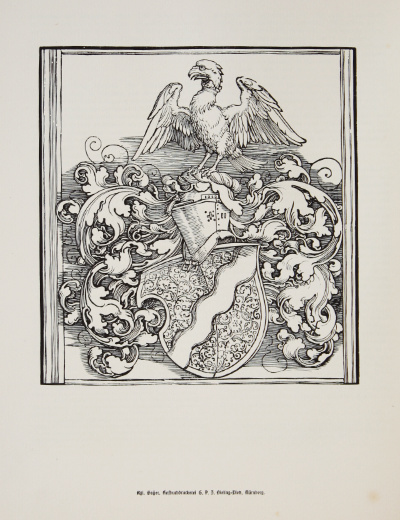

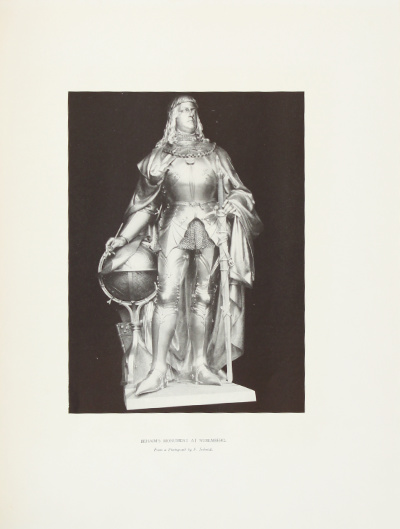
The first part of this volume (‘The Life’) provides a biographical memoir of Behaim (pp. 5-56), which is based on archival and printed sources, and examines critically the statements made about Behaim’s life by earlier historians (the appendices on pp. 107-116 provide transcriptions and translations into English of thirteen key contemporary documents, one of which is also reproduced in facsimile). One of the most striking aspects of this section is the woodcut of the arms of Behaim, which was engraved from a design made for Martin’s brother Michael Behaim (1747-1522) by his friend Albrecht Dürer. The woodblock remained in the possession of the Behaim family and was used by the Nuremberg printer G.P.J. Bieling-Dietz to produce the plate of the arms which faces p. 5. The woodblock was subsequently purchased by J.P. Morgan Jr from Baroness Franziska zu Behaim on 20 January 1926 and is now held by the Morgan Library & Museum, New York.
The second part of Martin Behaim. His Life and his Globe, ‘The Globe’ (pp. 57-105), examines the globe in four chapters: the first narrates the history of the globe; the second discusses earlier facsimiles of the globe (both spherical and planographic), and then explains Ravenstein’s methodology in the creation of his own facsimile; the third investigates the sources for the globe’s cartography (the four colour-printed maps show some of these sources and also modern maps for comparison); and the final chapter relates the circumstances of the globe’s creation before providing a detailed analysis of the nomenclature deployed by Behaim. In a pocket on the lower pastedown are the four sheets of the facsimile, each c. 762 x 610mm, which reproduce the globe at its original scale in the form of thirteen globe gores (eleven spanning 30º and two spanning 15º) and two polar calottes.
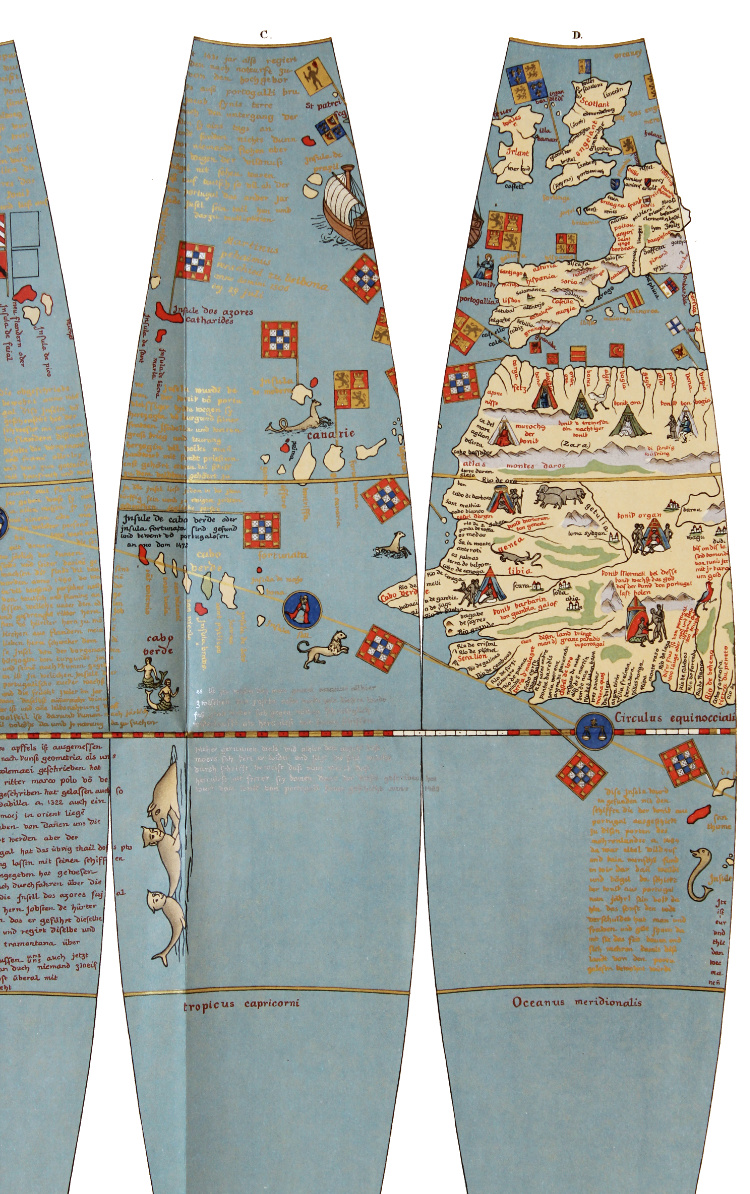
Perhaps due to the expense of printing the four sheets of facsimiles in colours, silver, and gold (which Ravenstein acknowledges on p. 62), Martin Behaim. His Life and his Globe was published in a handsomely produced limited of 500 copies in a holland-backed binding similar to those used by William Morris’s Kelmscott Press. The work was well received, and E. Heawood considered that its ‘value is twofold, for not only are we now for the first time presented with a trustworthy representation of the famous Nuremberg globe, made in the year of the discovery of America, but we have in the accompanying memoir the first critical and exhaustive study of the life of its maker, Martin Behaim’, before concluding his review with the words: ‘[t]he admirable copy of the original [globe], given in gores, with all the colours correctly reproduced, supplies for the first time a satisfactory and generally accessible basis for its study. The replica made at Jomard’s suggestion in 1847, though correct in its general features, was inaccurate in many details, and by careful collation with the original Mr. Ravenstein has been enabled to introduce a number of emendations, which render his reproduction a far nearer approach to the original than any previously produced. The technical work has been done by Mr. Griggs, whose skill in colour lithography is widely known’ (The Historical Review, vol. 24 (1909), pp. 791-792). Despite the passage of more than a century, Ravenstein’s work remains an authoritative account of Behaim’s globe.
For the Dürer woodblock, cf. A. Bartsch, Le Peintre graveur, VII, p. 167, no. 159; J. Meder, Dürer-Katalog, 287a.
£275
· · · · · · · · · · · · · · · · · · · · · · · · · ·
Our Terms & Conditions apply.

